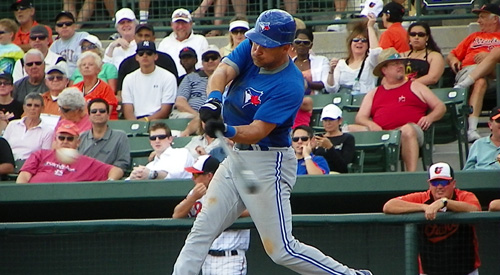
Calling it a career at the young age of 45
It’s a warm Friday night as the Toronto Blue Jays are about to face the Los Angeles Angels of Anaheim in the second game of a four-game series.
Just 25 minutes before the first pitch, my eye catches a solitary figure sitting in the Blue Jays’ dugout. It’s none other than infielder Omar Vizquel. He’s all by himself, collecting thoughts and – forgive the cliché – experiencing the calm before the storm.
It’s a captivating image.
He watches the grounds crew put on the finishing touches. He sees the fans trickle down to their seats. The blank canvas is slowly filling up.
He’s definitely thinking thoughts that span 24 seasons and beyond. Perhaps his mind has returned to 1989 when he played three games at Toronto’s former home, Exhibition Stadium. Yes, he’s been around that long.
Vizquel doesn’t need to be in the dugout. He wasn’t in the starting lineup; didn’t pinch hit or appear late in the game. In fact, the only time he left the dugout was to congratulate his teammates after a 7-5 victory.
[php snippet=1]
If this was a random utility player or a journeyman filling in a gap, no would notice. But when it’s Omar Vizquel, it’s a poetic slice.
If age is just a number, then Vizquel is the proof.
There aren’t many players in their mid-to-late 40s playing Major League Baseball. With Jamie Moyer’s release from Colorado, as well as his two failed comeback attempts in the Baltimore and Toronto farm systems, the 45-year-old Vizquel is the only one. Playing in your late 30s and early 40s is common. 20 MLB teams currently have at least one player between the ages of 37 and 41.
45 is a different matter.
But why would a 45-year-old still play when his age is considered elderly by professional sports standards? He has nothing else to prove: 11 gold gloves, three All-Star appearances, a career fielding percentage of .985. Does he love the game that much? Is it the drive for a World Series ring? He came close in 1995 and 1997.
The obvious answer is that he’s healthy and can still provide. His hitting stats are nowhere near the numbers he produced in the late 90s, though he was never viewed as one of the top hitters. Therefore, it’s all in his glove. He still has the skill: 78 chances so far in a limited role, just one error.
There’s also what he brings off the field.
He’s a mentor and a teacher; someone who can provide the experience and insight. Simply put, he’s a role model.
“The mentoring side is a benefit,” Jays manager John Farrell told MLB.com’s Anthony Castrovince in an article published last April. “But he’s still a very capable player… He comes in with what is, for me, a sure-fire Hall of Fame career, on a Minor League contract, and puts his ego aside and shows he loves to play the game. He plays with youthfulness, even at his age, that I think we all draw from.”
If all else fails, Vizquel can at least give his teammates (and fans) a laugh.
Last month, Vizqeul announced he would be retiring at the end of this season. But while his playing days will finish, it doesn’t mean he’s leaving baseball entirely.
“I’ve enjoyed this game a lot, but I think it’s time to pursue a new career as a coach or manager, and hopefully I’ll get that opportunity in the future,” Vizquel said in an interview with NESN.com.
Don’t forget about his off field hobbies, especially painting.
So as the second half commences, take a moment to savor the final months of Omar Vizquel’s career. Many baseball reporters describe him as a Hall of Famer and there’s no doubt he will have a place in Cooperstown one day.
He might only appear in a handful of games, but what “Little O” brings to the field cannot all be measured in statistics.
[php snippet=1]

